The debate on the impact of fretboard wood on tone has been the cause of many heated discussions. If you disregard all personal opinions and focus on facts alone – the answer would be yes, Laurel Fretboards are good enough.
But, to really get into it, it is important to understand the science behind it. Don’t be alarmed though, I won’t be making this neither too long nor overly complex.
In short, Indian Laurel and Rosewood fretboards sound surprisingly similar. Their colors differ slightly, with Laurel being medium brown in contrast to the darker, deeper brown hue of Rosewood. Both offer excellent playability and balanced tones, with Rosewood’s tone being slightly warmer.
Below, I’ll explore the distinct characteristics, advantages, and practical shortcomings of each contender.
Table of Contents
The Fretboard Fandango

For well over a century, guitarists and bass players have discussed, disagreed, argued and philosophized on the importance of the wood used to construct the instrument.
The truth is that the material used greatly influences tone quality, but guitar body wood plays a bigger part in shaping up the tonal characteristics compared to fretboard tonewood.
Maple, Ebony and Rosewood used to be the most common choices for guitar and bass manufacturers. Today however, there is an endless list of materials available to manufacturers, whether wood or synthetic, all of which affects the feel, the look, and to a minute degree, the sound of the instrument.
Fretboard wood faces significant physical challenges – it must be extremely durable to withstand the compression caused by the tension of the strings, and it must be hard enough to survive the friction and scratching of the actual strings pushed down onto it during play.
A Quick Overview of Both the Woods
For decades, Rosewood has been the standard choice for fretboards, owing to its natural beauty, durability, and tonal properties. It produces a warm, rich sound with a smooth sustain that many guitarists cherish.
Rosewood is a group of tropical trees from around the world, the use of which has mostly been banned following the CITES regulations in 2017, after several of the species became endangered. But the good news is that the ban has largely been lifted when it comes to its use in musical instruments.
It is a durable hardwearing wood that stands up admirably to the strain of performance. Even frequent use will not easily damage or wear it.
In response to the dwindling availability of Rosewood, guitar manufacturers began exploring other wood options for fretboards. Indian Laurel emerged as a sustainable and affordable alternative.
The Indian Laurel is an Asian species of tree, also known as India Walnut or India wood.
It is a moderately hard wood and can handle the strain of frequent performance without batting an eyelid. Not much difference in this department.
This wood has been steadily gaining popularity among guitarists for its striking resemblance to Rosewood in both appearance and tonal characteristics.
Appearance
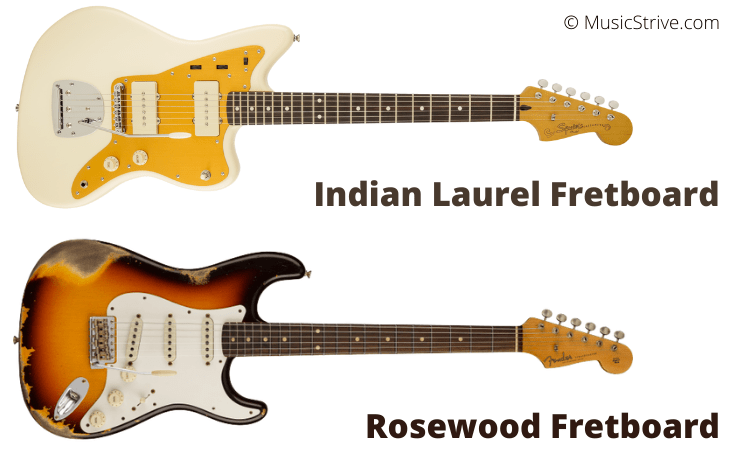
They both have a very similar look when used for fretboards too. Quite often, it is difficult to tell the two woods apart. This is especially true if the laurel is finished to resemble rosewood.
Indian Laurel Wood is a medium brown wood with occasional dark brown streaks and a straight grain that takes a nice high gloss finish. It’s ever so slightly more evenly colored than Rosewood throughout the fretboard.
Rosewood has a deep brown, sometimes purplish-brown color with resinous streaks of black. Even the grains of these wood types mostly resemble one another, and both have relatively lighter streaking.
Indian Laurel typically has a slightly lighter hue, accompanied by a more consistent grain pattern. In contrast, Rosewood often showcases darker streaks and a more varied grain pattern, giving it a more unique look.
Personally, I find the more consistent appearance of Indian Laurel more pleasing to the eye, owing to marginally less streaking and a more even color.
Feel
The feel of the fretboard is likely the most important factor to consider here. In this aspect, Indian Laurel and Rosewood are quite similar.
Both woods are soft to the touch with a very smooth playing feel, allowing your fingers to glide effortlessly across the fretboard.
Laurel can feel a tiny bit drier at first, but I got used to it pretty soon. It was pretty smooth though, even smoother than some of the Rosewood guitars that I’ve played.
If you’re a particular fan of the appearance and feel of rosewood, and want a rosewood fingerboard in a budget, you have two main options – Epiphone and Yamaha.
Epiphone offers various budget SG and Les Paul models with Rosewood fretboards, while Yamaha does the same with their Pacifica series of guitars.
Squier currently doesn’t produce any Rosewood-equipped guitars, and right now the cheapest Fender costs $999.
Tone & Sonic Qualities
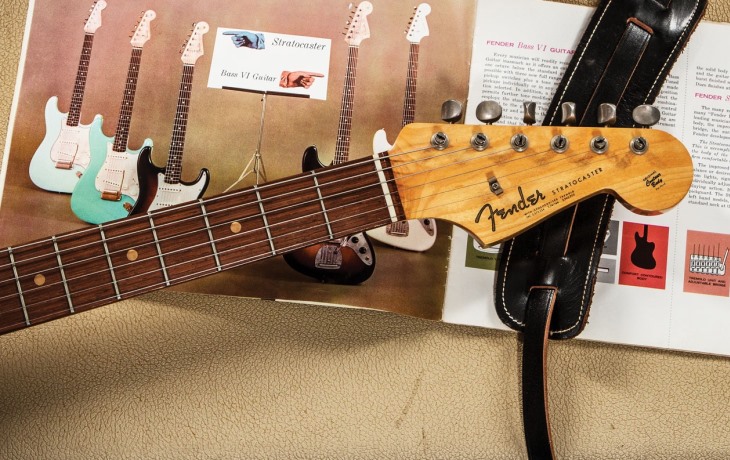
There are plenty of debates as to whether fretboard tonewoods matter at all when it comes to tone, especially in case of electric guitar. If you belong to the half that says they can perceive the tonal differences owing to different fretboard materials, read on.
Indian Laurel and Rosewood fretboards share many qualities when it comes to sound. Both woods are renowned for their warm, resonant tone and smooth sustain, making them highly sought after by musicians.
Both Rosewood and Indian Laurel fretboards tend to produce balanced tones across the entire frequency range. Some guitarists argue that Rosewood produces a marginally richer sound, while others find the differences to be negligible and hardly noticeable.
I’d say Indian Laurel is as close to Rosewood as possible tonally, without being Rosewood itself. The difference is simply not there, unlike in case of rosewood vs maple, or rosewood vs ebony.
In electric guitars, components like pickups, bridges and strings play a far more important role when it comes to tone. To re-emphasize, you shouldn’t shell out more for a guitar with a rosewood fingerboard for tone alone.
Durability and Maintenance
Durability is a crucial factor when choosing a fretboard material. Both Rosewood and Indian Laurel are dense, hardwoods that can withstand wear and tear over time. As a result, they are ideal choices for fretboards.
Some players might notice that Indian Laurel fretboards tend to feel smoother, offering an advantage to those who prefer a slicker playing surface.
Additionally, both woods require minimal maintenance, with the occasional application of fretboard oil being sufficient to keep them in top condition.
Affordability and Environmental Impact
As mentioned earlier, the limited availability of Rosewood has driven up its price and made it challenging to source. Indian Laurel is a more affordable and eco-friendly alternative, contributing to its increasing popularity among guitar manufacturers and players alike.
The sustainability of Indian Laurel also appeals to environmentally conscious guitarists who want to reduce their carbon footprint.
My Verdict on Indian Laurel Fretboards
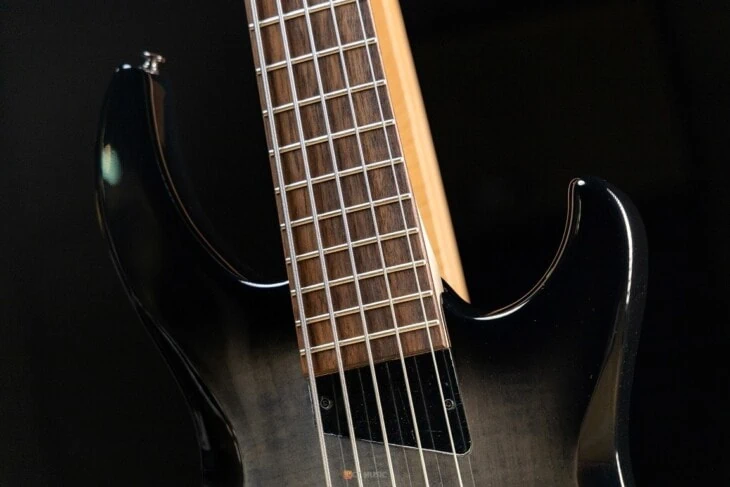
Advantages
- Tonal qualities comparable to Rosewood
- Visually appealing with a uniform grain pattern
- Durable and low-maintenance
- Budget-friendly and environmentally sustainable
Disadvantages
- Slightly less rich sound than Rosewood (subjective)
- Less variation in appearance compared to Rosewood
In summary, Indian Laurel fretboards are an exceptional alternative to Rosewood.
They offer similar tonal properties, a visually pleasing appearance, and excellent durability at a more affordable price. Furthermore, their sustainable nature makes them a responsible choice for environmentally conscious guitarists.
Notable Guitars with Indian Laurel Fretboards
Several guitar manufacturers have recognized Indian Laurel as a viable fretboard material. If you're interested in trying one out, check out these popular models.
Popular Squier Strat
This affordable and stylish guitar features an Indian Laurel fretboard, providing a warm and rich tone that's perfect for blues, rock, and various other genres. The classic Stratocaster design combined with the Indian Laurel fretboard makes it an excellent choice for both beginners and experienced players.
Popular Epiphone Les Paul
This guitar combines the iconic Les Paul design with an Indian Laurel fretboard, resulting in a versatile instrument suitable for a wide range of playing styles. The combination of the humbucker pickups and the Indian Laurel fretboard ensures a powerful yet warm and resonant sound, perfect for rock, blues, and jazz.
Cheap Squier Strat
The Squier Sonic Stratocaster, featuring an Indian Laurel fretboard, is an ideal entry-level guitar for beginners or a reliable backup for experienced players. Its combination of single-coil pickups and the Indian Laurel fretboard provides a versatile sound that caters to various genres, from classic rock to blues and pop. The familiar Stratocaster design, coupled with the affordable price tag, makes this guitar an attractive option for musicians on a budget.
The Role of Personal Preference
In the end, which tonewood is more suitable for you comes down to a simple point – personal preference. Some guitarists will gladly bet their lives that there is a significant difference between the two. Then of course there are just as many who deny any obvious change to tone.
Both woods offer unique benefits and aesthetic appeal.
Indian Laurel is an excellent choice for those seeking a more affordable and eco-friendly alternative to Rosewood, without compromising on tonal quality or durability.
As a guitarist, experimenting with different gear and materials is crucial to finding the perfect sound for your playing style. Don’t hesitate to try out various fretboard materials, including Indian Laurel, to discover what works best for you.
Keep in mind that every player’s preferences and needs are different; what may be the perfect fretboard material for one guitarist might not be suitable for another.
Remember, the choice of fretboard material should ultimately be based on the benefits it offers you as a guitarist. Factors such as tonal quality, affordability, aesthetics, and sustainability should all be taken into account when making your decision. Indian Laurel is a versatile option that’s worth considering in your quest for the perfect guitar.
Musicians often prefer to stick to what has been tried and tested over several decades, or even centuries. But like the manufacturers of our instruments, we have to move forward and keep up, or risk being left behind.
In Conclusion
Indian Laurel is not inferior (or superior) to the Rosewood in any way. In fact, it is very much on par and makes for an excellent substitute that does not significantly impact the feel and tone of your beloved instrument.
I will not go into the details of CITES and the ban of Rosewood in 2017 here, but since the relaxation of the regulations in 2019, manufacturers have started using Rosewood again.
It is however very clear, and sensible as well, that many manufacturers will be simply sticking to Laurel going forward for both cost and environmental concerns.

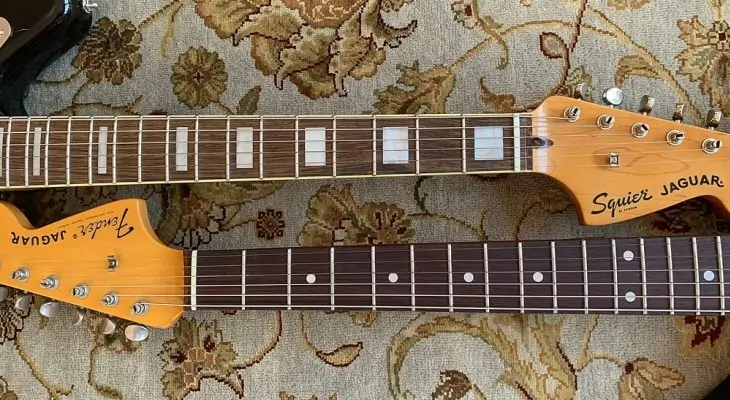
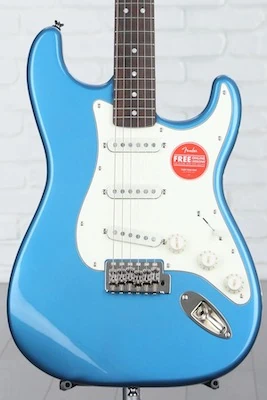
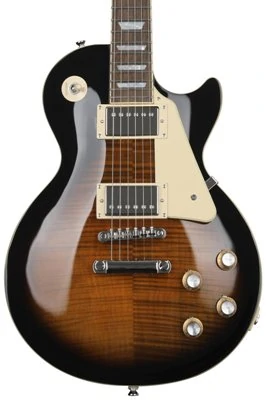
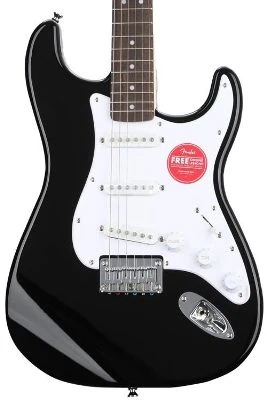
I’m playing in bands for 65 years and still doing around 80 paid gigs a year.
I started in the very late ’50s in NYC. My first real guitar was a Fender Jazzmaster, purchased in may 1960, with a rosewood finger board. Through the decades of changes in music, buying, selling, trading, and owning, countless of different guitars, they have always had either ebony or rosewood fingerboards rarely in a Telecaster: Maple but I ordered the Rosewood.
Now I’m not going to tell you I could hear the difference from miles away, but
to me; the look of the instrument means as much to me as the tuxedo I’m wearing on that bandstand. So looking at the guitars on the internet the Laurel appears somewhat pale in color and richness.
Your strings NEVER touch the wood of your neck. So really, beyond looks what does it matter what the wood is?
That’s interesting. My strings almost always touch the fretboard material. Does that mean I’m pressing to hard?
No it means you know what you`re talking about.
Are you referring to the layer of varnish or something? I’m confused why do you agree with both reasonings. I’m not sure now if my strings touch or not when I play, it feels like I’m compressing the string against the neck.
Ummm? Yes?
I’m absolutely certain that my strings will touch fretboard when set at .006 and I apply pressure to them with my fingers! Lol
yeah, that’s a negative on the idea strings don’t touch the fret board….unless you have one of those scalloped fingerboards like Yngwie, they definitely live on the board while you play. Every old guitar of mine has the dips worn into the rosewood and maple. Just look at any old 50’s Strat or Tele that has been played a bit. You’ll see the clear coat on the maple has worn through and the wood has divets.
The classic vibe does not need any hardware replaced…Now possibly pots wiring maybe..
That picture of the Squier Mascis Jazzmaster has a rosewood fingerboard, even though Squier and retailers describe it as Indian Laurel. That’s a picture of the old model. They do that because they know that no one likes the way Indian Laurel looks.
Ipe is a wood that comes very close to Ebony as a fretboard. Some Ipe is as black as Ebony. Some of it is similar in appearance to Rosewood. Ipe is better than Ebony in the sense that it doesn’t crack like some Ebony. There is also less finger-wear divots from Ipe than Ebony. I don’t understand why other luthiers don’t use Ipe. It makes a far superior fretboard than other woods. Mickey Johnson, JMB Guitars
Thank you for the insight. I have been battling over myself, would I go for a laurel fretboard on a guitar i would modify anyways… This article assured me that it’d be okay. The question is that I’d mod out a Squier Classic Vibe Strat, updating the pickups, electronics and the steel hardware, as well as the nut (if needed).
Thats simply not true that people dont like the way India Laurel looks.
Agreed. I think it looks better but I’ve been around for a while and know rosewood better than laurel by feel/tone.